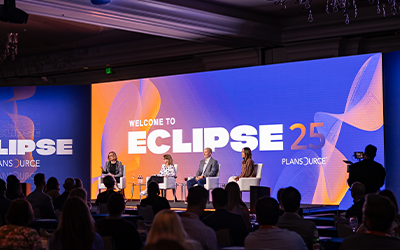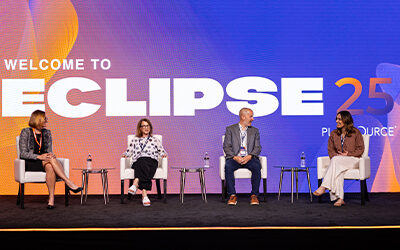As an HR professional, you spend countless hours researching new initiatives, negotiating with carriers and vendors, and executing exciting perks and programs for your organization. These benefits help the company achieve several goals, including recruiting and maintaining top talent and keeping costs in check.
But, what good is having great benefits if your employees are unaware of or unappreciative of the true value of your offerings?
Well, you’re in luck! We’ve got the perfect solution: total compensation statements.
These nifty HR handouts help convey an employee’s actual realized income and showcase the true investment you are making in them. And, they can introduce employees to additional perks and programs that they might otherwise be unaware of, thus increasing engagement and participation.
What is a total compensation statement?
Imagine this: A single, personalized document or webpage that showcases the total value of an employee’s financial rewards – the direct and indirect compensation offered by your company. That’s exactly what a total compensation statement is! Total rewards statement, the ‘hidden paycheck’, these helpful documents are an essential part of any HR arsenal.
Think of total compensation statements like a swiss army knife for HR. This handy tool can be used to recruit new talent by fully showcasing the value of a compensation offer and can be used to retain the talent you worked so hard to recruit by demonstrating growth over time.
Why produce a total compensation statement?
Total compensation statements can be helpful in four distinct areas of HR:
- Understanding
- Retention
- Morale
- Branding
Total compensation statements will help employees better understand their choices when it comes to the employee benefits that your company offers, which can in turn increase retention, improve morale, and solidify your company’s brand in the mind of employees.
What should a total compensation statement include?
Your total compensation statements should be comprehensive and include a detailed breakdown of every type of compensation offered by your organization. This includes salary, bonuses, insurance offerings, paid time off perks, etc.
- Salary or Hourly Wages
- Additional Income: Bonuses, commission, etc.
- Health Plan Benefits: Medical insurance, dental insurance, vision insurance
- Health Savings Accounts: HSAs, FSAs, HRAs
- Retirement Income: 401(k), IRA, Pension
- Income Replacement: Short-term disability, long-term disability
- Life Insurance
- Paid Time Off: Vacation, sick, bereavement, personal, volunteer, etc.
- Professional Development: College tuition reimbursement, professional membership dues, conference stipend, etc.
- Any other voluntary of ancillary offerings
In the statement, each category should include a breakdown of both employer and employee contributions.
Online vs Print Statements
When deciding on a total compensation statement approach, it is important to consider whether your statements should be print pieces that are either delivered by a manager or mailed, or if the piece should be created and delivered digitally. Let’s explore both options.
Print statements are best suited for a less tech-savvy workforce or a workforce that is in-field and does not have day-to-day access to a computer. Print statements might also be appropriate if you want the added value of having a one-on-one conversation with the employee’s direct manager or if you want to get the statement in front of a spouse or other household decision maker.
Digital
Digital statements are the preferred method of delivery for most organizations. Year to year data is easily stored for reference and employees are free to view the statements at any time, in any place, at their convenience. Digital statements are designed to be intuitive, interactive and mobile-friendly to optimize engagement. Also, note that digital statements can be downloaded as a PDF.
How long does it take to set up the statements?
Of course, this will vary by vendor. With the PlanSource solution, you can expect an 8-10 week turnaround time for statements to implement. This time includes time for data integrations, statement design and communication.
How do I communicate with my workforce?
Having a communication plan in place is the first step to ensuring maximum engagement with your compensation statements. We recommend a 4-6 week window for communication prior to statement implementation, in addition to strategic comms during and after go live.
Apply communication campaign best practices → Communicate early and often!
- Notifications and reminders
- Link to info materials
- Schedule comms ahead of time
- Use a timeline
- Comm regularly
When should I give out statements?
There are a few different times to distribute total compensation statements. One option is to release them at the beginning of the year, around the time that W-2s are distributed. This will serve as a reinforcement of the total value of an employee’s ancillary income outside of just their paid salary.
Another option is to time your statements around open enrollment, which will serve as a reminder of the real value of employer-sponsored benefits and help increase engagement.
A final option is to update a specific employee’s total compensation statement when a good employee is considering an offer from a different company or when presenting a new offer to a new recruit.
How often should I refresh and/or distribute statements?
This is really up to your organization. The frequency of updates should align with your internal resources and organizational goals. The most common frequency for compensation updates is either on an annual basis or quarterly, though digital statements make it very easy to ramp up or ramp down the frequency as needed.
How do I measure success?
As with anything, success is relative. In this case, success metrics will vary most greatly based on the size of your organization. In general, a 40% open rate is a good starting benchmark. Of course, if your organization is smaller, expect higher open rates. Or, if your organization is larger, expect lower open rates.
Johns Hopkins Health Care Case Study
Johns Hopkins had a short turnaround time for delivering compensation statements and needed a vendor that could combine data from multiple sources and provide customized statements per business unit. Not to brag, but we knocked it out of the park.
Are You Ready To Showcase Your True Value?
Help employees uncover their hidden paycheck. Contact us below for a quick demo of our total compensation statement solution.
Empathy, Innovation & Action: Top Takeaways from HR Leaders Who Spoke at Eclipse
Empathy, Innovation & Action:Top Takeaways from the HR Leaders Who Spoke at...
Charting the Future of PlanSource: Our Vision for What’s Ahead
Discover how PlanSource unveiled game-changing AI innovations at Eclipse 2025, transforming how HR leaders manage benefits and how employees choose them. The future of benefits starts here.
Navigating New Requirements with the Paperwork Burden Reduction Act
Navigating New Requirements with the Paperwork Burden Reduction...




